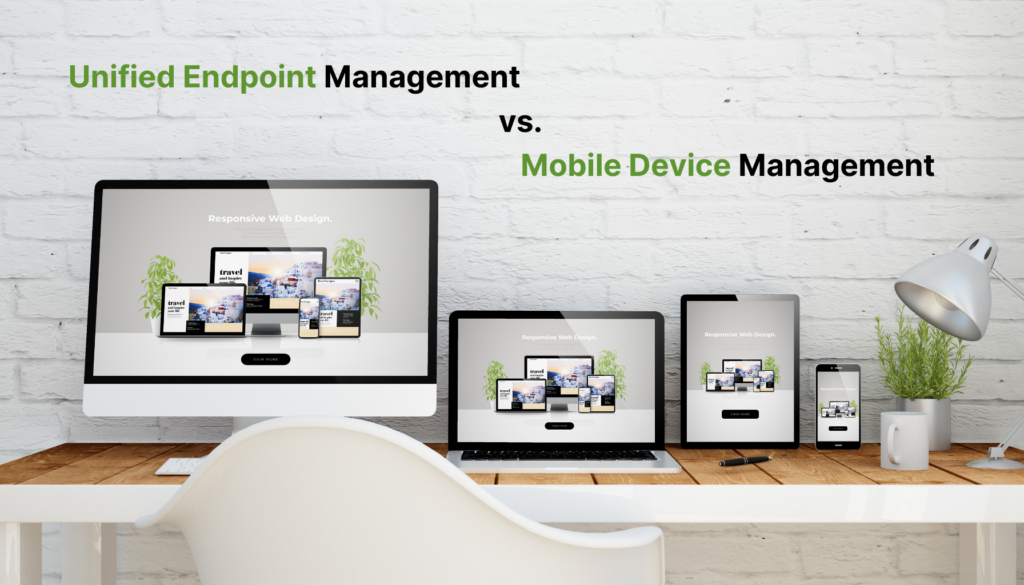Discover whether Unified Endpoint Management (UEM) or Mobile Device Management (MDM) is the better fit for your mobile IT strategy. We explore the pros and cons of each solution and provide practical tips.

Choosing Between UEM and MDM
Today, companies face the challenge of managing an ever-growing number of mobile devices. With the increasing use of smartphones, tablets, and laptops both in the office and on the go, it is crucial to manage these devices centrally and securely. Two main solutions often come into play: Mobile Device Management (MDM) and Unified Endpoint Management (UEM).
While both aim to simplify the management of devices, they differ significantly in scope and functionality. This article highlights the key differences and helps you determine which solution best suits your mobile IT strategy.
What is UEM and What is MDM?
Before diving into the differences between UEM and MDM, it’s essential to understand their definitions:
- Mobile Device Management (MDM): MDM is a solution specifically designed to manage mobile devices such as smartphones, tablets, and sometimes laptops. It offers tools for managing device policies, enforcing security measures, and monitoring device activity. The primary focus of MDM is to ensure the security and management of mobile devices.
- Unified Endpoint Management (UEM): UEM goes a step further by extending the scope of MDM to a broader range of endpoints, including desktops, laptops, servers, wearables, and IoT devices. UEM provides a more comprehensive solution for managing all types of endpoints within a company’s network. UEM is particularly useful for organizations that use a mix of mobile and traditional devices.
Why MDM Is Often the More Efficient Solution
Specialized for Mobile Devices
MDM solutions are specifically tailored for managing mobile devices, offering features designed to address the unique challenges that come with smartphones and tablets. These features include remote data wiping, enforcing password policies, and locking devices in case of loss. By focusing solely on mobile devices, MDM is highly efficient for companies that rely heavily on mobility.
Simpler Implementation and Management
Since MDM focuses only on mobile devices, its implementation is generally easier and faster. IT departments can expect less complexity and administrative burden, as MDM solutions are often more user-friendly and less comprehensive than UEM solutions. This not only simplifies daily operations but also reduces the need for extensive IT training.
Cost Efficiency
Because MDM solutions are less complex and focus solely on mobile devices, they tend to be more cost-effective than UEM solutions. Companies that primarily need to manage mobile devices can save money by choosing an MDM solution that meets their specific needs without the unnecessary extras that come with a UEM solution.
MDM Is Ideal for BYOD Environments In many organizations, the Bring Your Own Device (BYOD) concept is prevalent. Employees use their personal devices to access corporate resources. MDM solutions are perfect for such scenarios because they allow a clear separation between personal and corporate data on the device. Features like containerization ensure that the company’s data stays secure while leaving the employee’s personal data untouched.
When UEM May Be Overkill
While UEM is a powerful and comprehensive solution, it can sometimes be overkill, particularly when a company primarily needs to manage mobile devices. UEM solutions are usually more expensive, more complex, and require more resources, both in terms of implementation and ongoing management. For businesses that have only a few mobile devices or focus heavily on mobility, a UEM solution may be unnecessarily complex.
UEM solutions are especially valuable when a company manages a wide range of devices, including desktops, laptops, servers, and IoT devices. In these cases, UEM provides a unified platform for managing all endpoints under one roof. However, when the focus is on mobile devices, UEM can be too extensive and costly without delivering the necessary benefits.
Conclusion: MDM as a Focused Solution for Mobile Devices
For companies with a mobile-centric IT strategy, Mobile Device Management (MDM) offers a specialized, efficient, and cost-effective solution. MDM enables simple implementation and management of mobile devices and supports companies in meeting all data protection and security requirements.
Unified Endpoint Management (UEM) can be a good option when there is a broader range of devices to manage, but for many companies that focus on mobility, MDM is a far more pragmatic choice.
The right solution ultimately depends on your company’s specific needs and IT strategy. If your IT landscape is primarily made up of mobile devices, MDM might be the solution that best meets your requirements. Cortado is a leading MDM provider and offers specialized solutions that are user-friendly, fully secure and highly efficient. Cortado builds upon the highest security standards and a user-friendly interface to provide IT administrators with seamless management and mobile users with maximum productivity.
FAQs
- What is the main difference between UEM and MDM?
UEM manages a wide range of devices like desktops, laptops, and IoT devices, while MDM focuses exclusively on mobile devices. - Which companies should use UEM?
Companies with a diverse mix of devices, including PCs and IoT devices, benefit most from UEM solutions. - Is MDM more cost-effective than UEM?
Yes, MDM is typically more cost-effective because it is less complex and only focuses on mobile devices. - Which solution is better for BYOD environments?
MDM is ideal for BYOD environments because it allows for a clear separation between personal and corporate data on employee devices. - When is UEM overkill?
UEM can be overkill when a company primarily manages mobile devices and does not need to handle a large number of different endpoints. - How does MDM simplify mobile device management?
MDM provides features like remote data wiping, device locking, and security policy enforcement specifically tailored for mobile device management.

Enjoy the Ease of Mobile Device Management
With Cortado MDM, you’re ready to go right away and can manage mobile devices easily and securely.